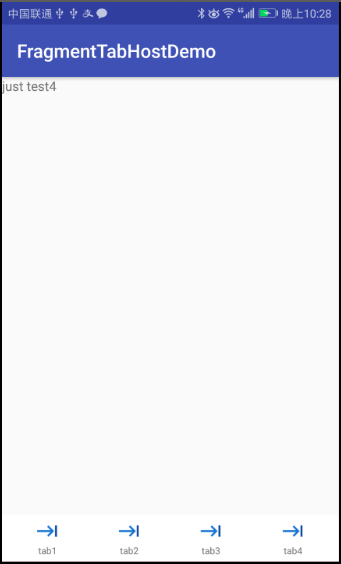转载请注明原文链接:http://www.cnblogs.com/yanyojun/p/8099523.html
代码已上传到github:https://github.com/YanYoJun/FragmentTabHostDemo
上一篇有讲过使用ViewPager来实现标签卡效果的。这一篇讲一下使用FragmentTabHost实现标签卡效果
惯例先上截图

第一步、布局文件
1 <?xml version="1.0" encoding="utf-8"?> 2 <LinearLayout xmlns:android="http://schemas.android.com/apk/res/android" 3 xmlns:app="http://schemas.android.com/apk/res-auto" 4 xmlns:tools="http://schemas.android.com/tools" 5 android:layout_width="match_parent" 6 android:layout_height="match_parent" 7 android:clipToPadding="true" 8 android:fitsSystemWindows="true" 9 tools:context=".MainActivity"> 10 11 <android.support.v4.app.FragmentTabHost 12 android:id="@+id/tab_host" 13 android:layout_width="match_parent" 14 android:layout_height="match_parent"> 15 16 <LinearLayout 17 android:layout_width="match_parent" 18 android:layout_height="match_parent" 19 android:orientation="vertical"> 20 21 <FrameLayout 22 android:id="@android:id/tabcontent" 23 android:layout_width="match_parent" 24 android:layout_height="0dp" 25 android:layout_weight="1"></FrameLayout> 26 27 <TabWidget 28 android:id="@android:id/tabs" 29 android:layout_width="match_parent" 30 android:layout_height="wrap_content" 31 android:layout_gravity="bottom" 32 android:background="#FFFFFF" 33 android:divider="@null" 34 android:padding="5dp"></TabWidget> 35 </LinearLayout> 36 37 </android.support.v4.app.FragmentTabHost> 38 39 </LinearLayout>
第二步代码实现:
1 package com.plbear.yyj.fragmenttabhostdemo 2 3 import android.support.v7.app.AppCompatActivity 4 import android.os.Bundle 5 import android.widget.TextView 6 import kotlinx.android.synthetic.main.activity_main.* 7 8 class MainActivity : AppCompatActivity() { 9 var titles = arrayOf("tab1","tab2","tab3","tab4") 10 var tabImg = arrayOf(R.drawable.tab,R.drawable.tab,R.drawable.tab,R.drawable.tab) 11 var fragments = arrayOf(MyFragment1::class.java, Fragment2::class.java, Fragment3::class.java, Fragment4::class.java) 12 13 14 override fun onCreate(savedInstanceState: Bundle?) { 15 super.onCreate(savedInstanceState) 16 setContentView(R.layout.activity_main) 17 initTabWidget() 18 } 19 20 fun initTabWidget(){ 21 tab_host.setup(this,supportFragmentManager,android.R.id.tabcontent) 22 23 for(i in 0..3){ 24 var v = layoutInflater.inflate(R.layout.layout_tab,null) 25 var img = v.findViewById<android.widget.ImageView>(R.id.iv_tab) 26 var lab = v.findViewById<TextView>(R.id.tv_tab) 27 img.setImageResource(tabImg[i]) 28 lab.setText(titles[i]) 29 tab_host.addTab(tab_host.newTabSpec(""+i).setIndicator(v),fragments[i],null) 30 } 31 tab_host.setCurrentTabByTag("1") 32 } 33 }
主要的实现都在initTabWidget中